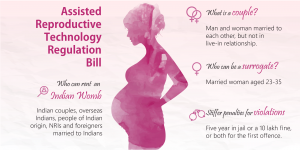In this blog post, Srishti Khindaria, a student of Amity Law School, Delhi, Guru Gobind Singh Indraprastha University, analyses how surrogacy is leading to serious troubles instead of solving problems in the lives of people and also how the government is undertaking certain legislative actions to safeguard the rights of surrogate mothers.
Some women due to certain biological or physiological conditions are unable to give birth to their off-springs. They thus go searching for alternative solutions and surrogacy is one of the most viable options. Advancement in the field of assisted reproductive techniques (ARTs) has revolutionized the process of surrogacy, thus making it the most sought after options. This system has been a ray hope to many infertile couples.
The word ‘surrogate’ literally means ‘substitute.’ It means that the genetic-biological mother is substituted by the surrogate mother. In common parlance, a surrogate mother is someone who is hired to bear a child, which is handed over to an employer at its birth. According to the Assisted Reproductive Technology (Regulation) Bill 2014 “surrogacy” means an arrangement in which a woman agrees to a pregnancy, achieved through assisted reproductive technology, in which neither of the gametes belongs to her or her husband, with the intention to carry it and hand over the child to the commissioning couple for whom she is acting as a surrogate. [1]
In the past, surrogacy arrangements were confined to close kith and kin, family or friends and usually a selfless deed. However, with an introduction of financial arrangements the ‘network of surrogacy’ has extended beyond the family, community, state and in recent times even the country, the industry has been commercialized to such an extent that surrogate wombs are now ‘recruited’ and ‘rented’ and agencies- that make huge profits- have cropped up. Such rapid commercialization raises fears of malpractices like black marketing, baby selling, and breeding farms. Some agencies have degraded pregnancy under surrogacy to a ‘service’ and the baby a ‘product’.
Troubles with Surrogacy in India
Surrogacy is estimated to be an industry worth nearly $2.3 billion; however surrogate mothers in India are less than tenth of what they would ordinarily get in any other part of the world. With a rapid surge in the number of IVF clinics, the absence of a rigid regulatory framework and ready availability of poor women who are willing to rent out their wombs, India has become an attractive option. However, all of this comes at a cost.
At one glance, surrogacy seems like a highly viable option, the poor surrogate gets much-needed money, and an infertile couple gets a child, but if we dig deeper, the real picture is much harsher. Due to lack of a legislative framework, both surrogate mothers and the parents are in most cases exploited, and commercial agencies and middlemen end up earning profits. There is no transparency and a high risk of getting tangled in legal hassles due to the unpredictable regulations regarding surrogacy in our country. Legal since 2002, commercial surrogacy has been open to grave misuse in India.
Under the Artificial Reproductive Technology (Regulation) Bill a surrogate mother ‘is a woman who agrees to have an embryo generated from the sperm of a man who is not her husband, and the oocyte for another woman implanted in her to carry the pregnancy to full term and deliver the child to its biological parents(s).’
By this definition, any surrogacy contract which involves the woman using her oocyte or egg to bear the child along with that of the commissioning man would be illegal. Also by the definition of surrogacy under section 2 (zq) all fertile surrogate mothers will have to use necessarily technology used to infertility treatment- i.e. in-vitro technologies- even if pregnancy can be introduced by other methods such as artificial insemination, which is much safer. Further, there is not standardization of the drugs used, no proper procedure of documentation, lack of information to the surrogate mothers about the side-effects of the drugs used and no limit set as to the number of times a woman may go through such a procedure.
Surrogacy that crosses borders also leads to several problems of citizenship, nationality, parentage, motherhood and also rights of the child. There are several occasions where children are denied nationality in the country of their actual parents which could result in a long-winding legal battle as happened with German couple who had twin surrogate children or an Israeli couple who underwent a DNA test to establish their parentage, there are also several instances where at a later stage the child was abandoned by the intended parents and had to spend his/her life in an orphanage, which hampers the growth and well-being of the child.
Changes and Legislative Action
In light of the Assisted Reproductive Technology (Regulation) Bill, 2014
India, as mentioned earlier, has emerged as the booming market for surrogacy. Cheap medical facilities and advance know-how in reproductive technologies coupled with backward socio-economic conditions and lack of firm legislative frameworks have led to making Indian a popular destination. Reports suggest that the revenue from commercial surrogacy could be anywhere $500 million to $2.3 billion, annually. A major reason for this is the influx of foreigners availing such services in India. However, developments over the past few months may have a major impact on the outflows of this industry and also possibly help safeguard interests of surrogate mothers.
Firstly, the Union Health Ministry in 2015 sought a permanent ban on commercial surrogacy in India. And according to the guidelines issued by the Department of Health Research (DHR), the import of ‘human embryo’ except for research purposes has also been banned. This has been seen as a significant step in insuring the rights of surrogate mothers and the children they bear. The Health Ministry’s affidavit clearly states “The Government of India does not support commercial surrogacy”, and that surrogacy should be available to Indian married infertile couples only and not to foreigners.”
Also, the new Assisted Reproductive Technology (Regulation) Bill, 2014 has been released by the Health Ministry, which seeks to restrict ART services in India to Indians only. The bill follows previous legislations in 2008, 2010 and 2013; the law commission had also commented on a need for ART regulation and the Indian Council for Medical Research developed guidelines to compensate for the legislative vacuum.
According to Ministry of Home Affairs (MHA), guidelines dated July 9, 2012, surrogacy was restricted to foreign nationals or a man and woman who had been married for at least two years. However the new 2014 Bill lays down more stringent laws; surrogacy is now restricted to married Indian infertile couples only, thus debarring all foreign nationals other than married PIOs (Person of Indian Origin), OCIs (Overseas Citizen of India) and NRI (Non-Resident Indian). It also seeks to end all forms of commercial surrogacy.
Some of the other prominent provisions of the bill are as follows:
- The bill by defining a couple as a “married man and woman” shuts doors on homosexuals and people in live-in- relationships.
- The bill proposes to make mandatory for all couples who commission surrogacy to accept custody of the child/children irrespective of any inherent abnormality that may be present.
- The couple shall also have to submit a certificate indicating that the child born through surrogacy is genetically linked to them and that they child shall not be involved in any pedophilia or pornography.
- Married, single, divorced or widowed women are allowed to act as surrogates. The minimum age of a surrogate mother shall be 23 years and maximum 35 years, and she must have at least one live child of her own who is at least three years old. And that no woman shall be allowed to act as a surrogate for more than one successful live birth in her lifetime, and there must be a time gap of at least two years between the surrogate delivery and that of her child.
- If a child is born to a foreign nation married to an Indian citizen by sperm/egg donation or surrogacy, then the child shall not be an Indian citizen, despite that fact that he/she was born in India. The child shall be entitled to Overseas Citizenship of India under Section 7A of the Citizenship Act, 1955.
- The draft also includes various provisions to regulate the clinics that provide such facilities in India. It states that not ART clinic shall provide the couple with a child of pre-determined sex and no ART clinic, or bank shall provide any information about the surrogate or potential surrogate to anyone.
Conclusion
Such steps do seem like the way forward in safeguarding interests of all parties; the childless couple, the surrogate mother and the newborn child. These are essential to prevent exploitation, my middlemen. However, such drafts just on paper will not help, it is essential that a firm legislation is passed as soon as possible by the legislators of our country to ensure that surrogate motherhood which is seen as an ethical way to provide childless couples with children does not turn into a completely commercialized sector with no ethics or responsibility and severe exploitation of the surrogate mother.
Footnote:
[1]Assisted Reproductive Technology (Regulation) Bill 2014, Section 2 (zq)
 Serato DJ Crack 2025Serato DJ PRO Crack
Serato DJ Crack 2025Serato DJ PRO Crack












 Allow notifications
Allow notifications



